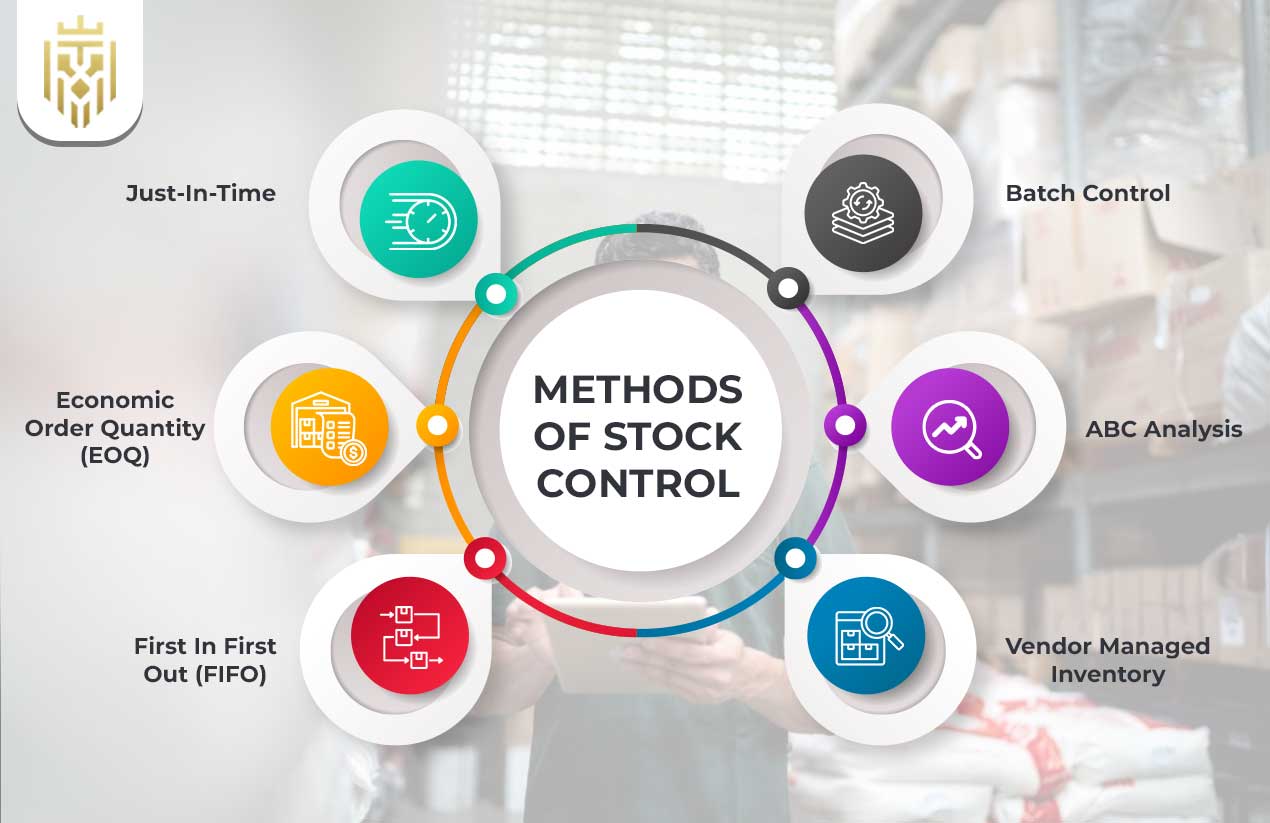What is Stock Control?
Stock control, also known as inventory control, ensures businesses maintain ideal inventory levels to meet customer demand efficiently. An effective stock control process balances order fulfilment, minimises costs, and mitigates the risk of overstocking or under stocking. This systematic approach supports operational efficiency by aligning inventory levels with business needs, improving overall supply chain effectiveness.
Stock Control Methods:
Stock control methods like Just-In-Time (JIT), Economic Order Quantity (EOQ), FIFO, Vendor Managed Inventory (VMI), and ABC analysis ensure efficient inventory management by optimising stock levels, minimising costs, and meeting demand effectively.

Just In Time:
Just in time inventory management focuses on receiving inventory only when required, minimising holding costs and storage needs. By collaborating with suppliers for timely deliveries, businesses can enhance efficiency while avoiding buffer stock. Though JIT reduces waste, it carries the risk of stockouts if suppliers fail to deliver on time, emphasising the importance of streamlined stock control methods.
Economic Order Quantity(EOQ):
The economic order quantity method determines the ideal order size to minimize costs related to ordering and storage. This method improves inventory planning, reduces lead times, and ensures customer demand is met efficiently. By integrating EOQ into a just in inventory stock control system, businesses can optimize supply chain operations and enhance profitability through precise inventory management.
First in First Out (FIFO):
The FIFO method ensures the oldest stock is used first, reducing the risk of obsolescence or expired goods. This stock control method is essential for maintaining product quality and safety, especially in perishable goods. Businesses using FIFO require organized inventory systems and staff training to align inventory turnover with demand, enhancing customer satisfaction and operational efficiency.
Vendor Managed Inventory:
Vendor managed inventory shifts stock control responsibility to suppliers, who manage inventory levels based on buyer-provided data. This approach reduces under-stocking risks and improves supply chain agility. VMI is a collaborative stock control process that optimises stock levels, shortens replenishment times, and enhances inventory visibility for both suppliers and buyers.
ABC Analysis:
ABC analysis categorises inventory into high (A), medium (B), and low (C) value groups, helping businesses prioritise high-value stock. This stock control method optimises inventory management, reduces costs, and ensures efficient tracking of critical items. By focusing on high-value products, businesses can enhance profitability and streamline resource allocation across inventory categories.
Batch Control:
Batch control involves tracking stock through unique identifiers, such as lot or production numbers, ensuring traceability for quality and safety. This stock control method is vital for managing recalls, as it identifies affected batches precisely. By implementing batch control, businesses can uphold product safety standards and maintain customer trust.
Stock Ordering Process:
The stock ordering process involves order placement, inventory sourcing, picking and packing, shipping, and real-time tracking with customer support, ensuring efficient replenishment, accurate fulfilment, and enhanced customer satisfaction in the supply chain.

Order Placement:
The stock control process includes order placement, which is the correct communication of purchase needs to suppliers or brokers. This means that there is timely procurement and there is seamless stock replenishment. Clear guidelines and frequent communication with suppliers help streamline order placement, avoiding delays and ensuring efficient inventory management.
Inventory Sourcing:
Inventory sourcing is the identification of reliable suppliers to meet raw material or product needs to improve supply chain efficiency. The effective stock control methods are backed by a robust sourcing process that is consistent and cost-effective. Regular supplier evaluations and performance reviews strengthen relationships and help maintain consistent quality and pricing over time.
Picking and Packing:
Batch or zone picking are among the strategies for optimised picking and packing to prepare orders as efficiently as possible. This stage of the stock control process reduces errors, reduces handling time, and improves order fulfilment accuracy. Implementing technology like barcode scanners enhances accuracy and speeds up the picking process in busy warehouses.
Shipping:
Shipping completes the stock control process by preparing and dispatching orders with correct labels and tracking information. Fast shipping means getting your order delivered on time and gaining the trust of customers. Collaborating with reliable logistics providers ensures smooth delivery operations and enhances customer satisfaction through timely updates.
Tracking and Customer Support:
The stock control process is enhanced by real-time order tracking and responsive customer support by giving updates and solving post-delivery problems to enhance high customer satisfaction and loyalty. Offering personalized assistance and easy return processes strengthens customer trust and encourages repeat business.
Stock Control System:
The just in inventory stock control system controls stock levels, prevents overstocking and keeps capital efficiency. Purchasing, tracking, storage and reordering are all part of it. Traditional manual systems are now supported by automated solutions which help in streamlining inventory management and making stock management error free.
Stock Control Software:
Inventory management with stock control software is automated and free of manual errors and visibility. Real time updates, analytics, and automated workflows make stock control features better and a more efficient supply chain. The modern businesses cannot afford to do without this software as it reduces stockouts, minimises storage cost and provides timely order fulfilment,
How to Improve Stock Control in your E-commerce Business?
Use stock control software to monitor real time stock levels and automate reordering processes. Implement just in time inventory management and ABC analysis to reduce inventory efficiency and focus on high value items. Audit inventory, organize products to streamline stock control process and prevent stockouts or overstocking in your e commerce business.
FAQs
-
What do you mean by stock control?
Stock control is managing inventory levels to meet customer demand efficiently while minimising costs, ensuring optimal stock availability, and reducing risks of overstocking or stockouts.
-
What are the Four Types of Stock Control?
The four types of stock control include Just-In-Time (JIT), Economic Order Quantity (EOQ), FIFO (First In First Out), and ABC analysis, each designed to optimize inventory management and streamline processes.
-
What are the best methods of Stock Control?
The best stock control methods include Just-In-Time, FIFO, Economic Order Quantity, Vendor Managed Inventory, and ABC analysis, focusing on minimising costs, improving efficiency, and ensuring timely stock availability.
-
What is Stock Control Software?
Stock control software automates inventory management, offering real-time tracking, reducing storage costs, optimising order fulfilment, and enhancing supply chain efficiency through features like analytics, automated workflows, and inventory categorization.









